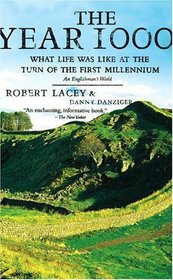Amaris R. (niffycat) reviewed The Year 1000 : What Life Was Like at the Turn of the First Millennium on + 2 more book reviews
Helpful Score: 1
I enjoyed how the author used the illustrations in the _Julius Work Calendar_ to give a glimpse into life in and around the year 1000. Each chapter has a theme, such as "Feasting" (April) and "War Games" (October.) This book is a quick, easy read, and it's full of interesting and memorable facts about life in England over 1000 years ago.
Helpful Score: 1
Although I like to think of myself as a "history buff," I wasn't offended by this "lighthearted look" at history, as one reviewer suggests. In fact, I so enjoyed it I debated whether to keep the book or re-post it. I re-posted it.
I learned a lot from the book and I'll try and give just a few examples. The people of this time were just as large as the people of our time, due to their good diet, healthy environment and work. We know this through the examination of their skeletons in graves. It wasn't until the population got so large later that people in the cities lived in unhealthy environments with poorer diets became shorter and weaker.
Then there was the Anglo-Saxon word for the people they forced off their lands into SW Britain---"wealisc---meaning foreign. This is where the word Welsh comes from. English wine was weak, only about 4% alcohol, and had to be drink soon or it spoiled. If they wanted to get drunk they drank mead. And the king's representative who controlled the local government was the "shire reeve" which eventually became "sheriff." I bet Wyatt Earp never knew that.
The food they ate consisted mainly of vegetables and grain, and a lot of pork. Mutton was slave food. Speaking of slaves, the early Germanic people---some of whom traveled west into new lands like Britain---often raided into what are now the Balkans for those, and thus Slav became slave. I was surprised to find they had no spinach until seeds were brought back by the Crusaders in the 12th century. As they had no sugar, as we know it, only honey which was heavily prized, skeletons from their graves have very little dental or jaw decay. Something we should all think about today.
There are 14 chapters in the book, the first and last are mainly introductory and summation. The other 12 are titled as months, and cover different subjects. The ladies will be interested in the "November" chapter which covers the status of women in this period. Apparently, the women had a great deal of equity with their men, and enjoyed many rights, including leadership of secular and religious communities. But as the Millennium was drawing to a close the Church stepped in and drastically changed all that.
I learned a lot from the book and I'll try and give just a few examples. The people of this time were just as large as the people of our time, due to their good diet, healthy environment and work. We know this through the examination of their skeletons in graves. It wasn't until the population got so large later that people in the cities lived in unhealthy environments with poorer diets became shorter and weaker.
Then there was the Anglo-Saxon word for the people they forced off their lands into SW Britain---"wealisc---meaning foreign. This is where the word Welsh comes from. English wine was weak, only about 4% alcohol, and had to be drink soon or it spoiled. If they wanted to get drunk they drank mead. And the king's representative who controlled the local government was the "shire reeve" which eventually became "sheriff." I bet Wyatt Earp never knew that.
The food they ate consisted mainly of vegetables and grain, and a lot of pork. Mutton was slave food. Speaking of slaves, the early Germanic people---some of whom traveled west into new lands like Britain---often raided into what are now the Balkans for those, and thus Slav became slave. I was surprised to find they had no spinach until seeds were brought back by the Crusaders in the 12th century. As they had no sugar, as we know it, only honey which was heavily prized, skeletons from their graves have very little dental or jaw decay. Something we should all think about today.
There are 14 chapters in the book, the first and last are mainly introductory and summation. The other 12 are titled as months, and cover different subjects. The ladies will be interested in the "November" chapter which covers the status of women in this period. Apparently, the women had a great deal of equity with their men, and enjoyed many rights, including leadership of secular and religious communities. But as the Millennium was drawing to a close the Church stepped in and drastically changed all that.





